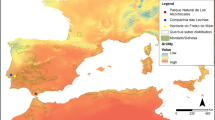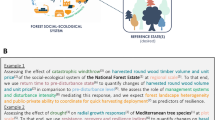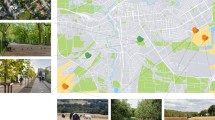Abstract
In Brazil’s semi-arid Northeast, most rural dwellers derive income from the dry Caatinga forest through livestock farming, fruit collection, and firewood extraction. However, recurring droughts and inadequate land use practices jeopardize farmers’ livelihoods. The drought-resistant, endemic Umbuzeiro tree provides fruit for direct consumption and allows for the creation of transformed products. The planting of this native species can enhance the well-being of the ecosystem and establish future benefits for smallholdings. However, it is crucial that when taking up innovative practices to cope with environmental change, a willingness to apply them should be fostered among local farmers. We used constellation analysis as a transdisciplinary approach to identify elements of current land management which subsequently defined the nodes of a Bayesian network (BN). We developed probabilities of practice uptake that strengthen success, namely the conservation of natural resources while securing the incomes of smallholders. In collaboration with stakeholders and experts, 25 identified nodes for the BN were tested under various scenarios. Adopting all suggested innovative practices secures the final objectives—ecosystem health and farmer benefits (approx. 90%). The analysis quantified the relevance of single issues that may impede farmers to adopt the practices, such as having to cultivate seedlings or avoiding long-term investments. Further crucial actions include the fencing-off of livestock and marketing pathways. Affordable credit, research, and supportive farmers’ institutions can encourage farmers to implement innovative practices. The use of modeled scenarios can provide evidence, which might encourage sustainable land management.


Similar content being viewed by others
References
AGAM Tecnologia Ltda, Chesf (2003) Estudo Ambiental da Barragem de Itaparica – Usina Hidro Elétrica Luiz Gonzaga. Unpublished
Aguilera PA, Fernández A, Fernández R, Rumí R, Salmerón A (2011) Bayesian networks in environmental modelling. Environ Model Softw 26(2011):1376–1388. https://doi.org/10.1016/j.envsoft.2011.06.004
Albuquerque SGD (1999) Caatinga vegetation dynamics under various grazing intensities by steers in the semi-arid Northeast, Brazil. J Range Manag 52(3):241–248. https://doi.org/10.2307/4003686
Albuquerque UP, de Medeiros PM, de Almeida A, Monteiro JM, Neto L, Ernani MF, Melo J, dos Santos JP (2007) Medicinal plants of the Caatinga (semi-arid) vegetation of NE Brazil: a quantitative approach. J Ethnopharmacol 1(114):325–354. https://doi.org/10.1016/j.jep.2007.08.017
Albuquerque UP, Soldati GT, Sieber SS, Medeiros PM, Sá JC, Souza LC (2011) Rapid ethnobotanical diagnosis of the Fulni-ô indigenous lands (NE Brazil): floristic survey and local conservation priorities for medicinal plants. Environ Dev Sustain 13(2):277–292. https://doi.org/10.1007/s10668-010-9261-9
Almeida A, Albuquerque UP, Castro CC (2011) Reproductive biology of Spondias tuberosa Arruda (Anacardiaceae), an endemic fructiferous species of the Caatinga (dry forest), under different management conditions in northeastern Brazil. J Arid Environ 75(4):330–337. https://doi.org/10.1016/j.jaridenv.2010.11.003
Andrade LA, Fabricante JR, Oliveira FX (2010) Impactos da invasão de Prosopis juliflora (sw.) DC. (Fabaceae) sobre o estrato arbustivo-arbóreo em áreas de Caatinga no Estado da Paraíba, Brasil. Acta Scientiarum. Biol Sci 32(3):249–255. https://doi.org/10.4025/actascibiolsci.v32i3.4535
Ango TG, Börjeson L, Senbeta F, Hylander K (2014) Balancing ecosystem services and disservices: smallholder farmers’ use and management of forest and trees in an agricultural landscape in southwestern Ethiopia. Ecol Soc 19(1). https://doi.org/10.5751/ES-06279-190130
Araújo Filho JC, Gunkel G, Sobral MC, Kaupenjohann M, Lopes HL (2013) Soil attributes functionality and water eutrophication in the surrounding area of Itaparica Reservoir, Brazil. Rev Bras Eng Agric Ambient 17(9):1005–1013. https://doi.org/10.1590/S1415-43662013000900014
Araújo Filho P, Santos C, Cavalcanti NB, Resende GM (2001) Influência do período de armazenamento das sementes de umbuzeiro na sua germinação e no desenvolvimento de plântula. Rev Bras de Armaz, Viçosa 26(2):36–39
Assis JMO, Sobral MC, Souza WM (2012) Análise de detecção de variabilidades climáticas com base na precipitação nas bacias hidrográficas do Sertão de Pernambuco. Rev Bras Geogr Fis 5(3):630–645
Bacon PJ, Cain JD, Howard DC (2002) Belief network models of land manager decisions and land use change. J Environ Manag 65(1):1–23. https://doi.org/10.1006/jema.2001.0507
Barreto LS, Castro MS (2007) Conservação do umbuzeiro (Spondias tuberosa Arr. Câmara) e de seus polinizadores no contexto agroecológico para a agricultura familiar indígena Pankararé no semiárido. Rev Bras Agroecol 2(2):1580–1583
Barreto LS, Castro, MS (2010) Boas práticas de manejo para o extrativismo sustentável do umbu. Embrapa Recursos Genéticos e Biotecnologia, Brasília
Barton DN, Kuikka S, Varis O, Uusitalo L, Henriksen HJ, Borsuk M, de la Hera, Africa, Farmani R, Johnson S, Linnell JDC (2012) Bayesian networks in environmental and resource management. Integr Environ Assess Manag 8(3):418–429. https://doi.org/10.1002/ieam.1327
Beusch C, Cierjacks A, Böhm J, Mertens J, Bischoff W-A, Araújo Filho JC, Kaupenjohann M (accepted with revisions) Biochar vs. clay: comparison of their effects on nutrient retention of a tropical Arenosol. Geoderma
Biswas AK, Cordeiro NV, Braga BPF, Tortajada C (eds) (1999) Management of Latin American river basins: Amazon, Plata, and São Francisco. The United Nations University. ISBN 92-808-1012-X
Blanc J, Kledal PR (2012) The Brazilian organic food sector. Prospects and constraints of facilitating the inclusion of smallholders. J Rural Stud 28(1):142–154. https://doi.org/10.1016/j.jrurstud.2011.10.005
Bromley J (2005) Guidelines for the use of Bayesian networks as a participatory tool for water resource management. Centre for Ecology and Hydrology, Wallingford
Bruns E, Ohlhorst D, Wenzel B, Köppel J (2011) Renewable energies in Germany’s electricity market. A biography of the innovation process. Springer Netherlands, Dordrecht
Bryan BA, Raymond CM, Crossman ND, Macdonald DH (2010) Targeting the management of ecosystem services based on social values: where, what, and how? Landsc Urban Plan 97(2):111–122. https://doi.org/10.1016/j.landurbplan.2010.05.002
Cain J (2001) Planning improvements in natural resources management. Guidelines for using Bayesian networks to support the planning and management of development programmes in the water sector and beyond. Centre for Ecology & Hydrology, Wallingford
Cain JD, Jinapala K, Makin W, Somaratnab PG, Ariyaratnab R, Perera R (2003) Participatory decision support for agricultural management. A case study from Sri Lanka. Agric Syst 76(2):457–482. https://doi.org/10.1016/S0308-521X(02)00006-9
Campos JNB (2015) Paradigms and public policies on drought in Northeast Brazil: a historical perspective. Environ Manag 55:1052–1063. https://doi.org/10.1007/s00267-015-0444-x
Castelletti A, Soncini-Sessa R (2007) Bayesian networks and participatory modelling in water resource management. Environ Model Softw 22:1075–1088. https://doi.org/10.1016/j.envsoft.2006.06.003
Cavalcanti NB, Resende GM (2004) Danos provocados por insetos a sementes do imbuzeiro no semi-árido do Nordeste brasileiro. Caatinga Mossoró-RN 17(2):93–97
Cavalcanti NB, Drumond MA, Resende GM (2004) Uso das folhas do umbuzeiro (Spondias tuberosa Arruda) na alimentação de caprinos e ovinos no Semi-Árido Nordestino. Agrossilvicultura, Vicosa 1(2):131–134
Cavalcanti NB, Resende GM, Drumond MA (2006) Período de dormência de sementes de imbuzeiro. Rev Caatinga 19(2):135–139
Cavalcanti NB, Resende GM, Brito LL (2009) Regeneração natural e dispersão de sementes do imbuzeiro (Spondias tuberosa Arruda) no sertão de Pernambuco. Eng Ambient 6(2):342–357
Cernea MM (1991) Putting people first. Sociological variables in rural development, 2nd edn. Oxford University Press, New York
Chen H, Pollino C (2012) Good practice in Bayesian network modelling. Environ Model Softw 37:134–145. https://doi.org/10.1016/j.envsoft.2012.03.012
Costa dA (2014) Sustainable dam development in Brazil: the roles of environmentalism, participation and planning. In: Scheumann W, Hensengerth O (eds) Evolution of dam policies. Evidence from the big hydropower states. Springer, Berlin, pp 13–53
Durlak JA, DuPre EP (2008) Implementation matters: a review of research on the influence of implementation on program outcomes and the factors affecting implementation. Am J Community Psychol 41(3–4):327–350. https://doi.org/10.1007/s10464-008-9165-0
Düspohl M, Frank S, Doell P (2012) A review of Bayesian networks as a participatory modeling approach in support of sustainable environmental management. J Sustain Dev 5(12). doi: https://doi.org/10.5539/jsd.v5n12p1
Edelstein M (2004) Grafting vegetable-crop plants: pros and cons. In: Cantliffe DJ, Soffella PJ, Shaw NL (eds) Proceedings of the VIIth International Symposium on Protected Cultivation in Mild Winter Climates. Production, pest management and global competition: Kissimmee, Florida, USA, March 23–27, 2004. ISHS, Sci Hortic [Leuven, Belgium], pp 235–238
Embrapa (1991) Programa Nacional de Pesquisa em Fruteiras de Clima Tropical-PNPFCT, 33rd edn. Cruz das Almas, Bahia
Fabricante JR (2013) Plantas Exóticas e Exóticas Invasoras da Caatinga, 1st edn, vol 1. Bookess, Florianápolis
Figueiredo JM, Araújo JM, Pereira ON, Bakke IA, Bakke OA (2012) Revegetation of degraded Caatinga sites. J Trop For Sci 24(3):332–343
Florin MJ, van Ittersum MK, van de Ven GW, van de Ven, Gerrie WJ (2013) Family farmers and biodiesel production: systems thinking and multi-level decisions in Northern Minas Gerais, Brazil. Agric Syst 121:81–95. https://doi.org/10.1016/j.agsy.2013.07.002
Grêt-Regamey A, Brunner SH, Altwegg J, Christen M, Bebi P (2013) Integrating expert knowledge into mapping ecosystem services tradeoffs for sustainable forest management. Ecol Soc 18(3):34. https://doi.org/10.5751/ES-05800-180334
Kelly R, Jakeman AJ, Barreteau O, Borsuk ME, El Sawah S, Hamilton SH, Henriksen HJ, Kuikka S, Maier HR, Rizzoli AE, van Delden H, Voinov A (2013) Selecting among five common modelling approaches for integrated environmental assessment and management. Environ Model Softw 47:159–181. https://doi.org/10.1016/j.envsoft.2013.05.005
Lima Jd (1996) Plantas forrageiras das Caatingas usos e potencialidades. Programa Plantas do Nordeste -PNE; Royal Botanic Gardens -RBG-KEW, Petrolina-PE, Brazil
Lima DJJ, Ikeda AA, Camponar MC (2012) Creation of a brand of origin in small farmers organizations in Brazil: the case of Coopercuc. In: IFAMA (ed) 22nd Annual World Forum & Symposium. The Road to 2050. The China factor, vol 22, Shanghai, China, pp 3–20
Lins N, Ernani MF, Peroni N, Albuquerque UD (2010) Traditional knowledge and management of umbu (Spondias tuberosa, Anacardiaceae): an endemic species from the semi-arid region of Northeastern Brazil. Econ Bot 64(1):11–21. https://doi.org/10.1007/s12231-009-9106-3
Machado I, Barros LM, Sampaio EVSB (1997) Phenology of Caatinga species at Serra Talhada, PE, Northeastern Brazil. Biotropica 29(1):57–68. https://doi.org/10.1111/j.1744-7429.1997.tb00006.x
Maneta MP, Torres MO, Wallender W, Vosti S, Kirby M, Bassoi LH, Rodrigues L (2009) Water demand and flows in the São Francisco River Basin (Brazil) with increased irrigation. Agric Water Manag 96(8):1191–1200. https://doi.org/10.1016/j.agwat.2009.03.008
McCann R, Marcot B, Ellis R (2006) Bayesian belief networks: applications in ecology and natural resource management. Can J For Res 36(12):3053–3062. https://doi.org/10.1139/x06-238
MDA/SDT (2009) Plano Territorial de Desenvolvimento Rural Sustentável. Território Itaparica - Bahia e Pernambuco. Ministério do Desenvolvimento Agrário. Secretaria de Desenvolvimento Territorial, Paulo Afonso
Mertens J, Germer S, Germer J (2015) Soil amendment impact on root and root-tuber development of Umbu trees In: Tropentag 2015 (ed) Management of land use systems for enhanced food security: conflicts, controversies and resolutions. Tropentag, September 16–18, 2015 in Berlin, Germany
Mertens J, Germer J, de Araújo Filho JC, Sauerborn J (2016) Effect of biochar, clay substrate and manure application on water availability and tree-seedling performance in a sandy soil. Arch Agron Soil Sci 63:1–15. https://doi.org/10.1080/03650340.2016.1249473
Mohammadi SA, Prasanna BM (2003) Analysis of genetic diversity in crop plants—salient statistical tools and considerations. Crop Sci 43(4):1235–1248. https://doi.org/10.2135/cropsci2003.1235
Monteiro AA (2007) Patrimônio cultural, luta e identidade. Os indígenas Pankararu em São Paulo. In: Lima Filho MF, Eckert C, Beltrão JF (eds) Antropologia e patrimônio cultural. Diálogos e desafios contemporâneos. Nova Letra; Associação Brasileira de Antropologia, Blumenau, pp 157–174
Neyberg B, Marcot B, Sulyma R (2006) Using Bayesian belief networks in adaptive management. Can J For Res 36(12):3104–3116. https://doi.org/10.1139/x06-108
Ohlhorst D, Schön S. (2015) Constellation analysis as a means of interdisciplinary innovation research–theory formation from the bottom up. Hist Soc Res 40, 3 (153), Special Issue: Methods of Innovation Research: Qualitative, Quantitative and Mixed Methods Approaches (2015), pp. 258–278
Oliveira DAS, Almeida-Cortez JS, Candeias ALB, Cierjacks A (submitted) Land-use changes after dam construction affect population dynamics of a threatened fruit tree in northeastern Brazil
Pannell DJ, Marshall GR, Barr N, Curtis A, Vanclay F, Wilkinson ER (2006) Understanding and promoting adoption of conservation practices by rural landholders. Aust J Exp Agric 46(11):1407–1424. https://doi.org/10.1071/EA05037
Pellet J, Elisseeff A (2008) Using Markov blankets for causal structure learning. J Mach Learn Res 9:1295–1342
Pollino CA, Henderson C (2010) Bayesian networks: a guide for their application in natural resource management and policy. Technical Report
Prado DE, Gibbs PE (1993) Patterns of species distributions in the dry seasonal forests of South America. Ann Mo Bot Gard 80(4):902–927. https://doi.org/10.2307/2399937
Reis RV, Fonseca N, Ledo CA d S, Gonçalves LSA, Partelli FL, Silva MG d M, Santos EA (2010) Estádios de desenvolvimento de mudas de umbuzeiros propagadas por enxertia. Ciênc Rural 40(4):787–792. https://doi.org/10.1590/S0103-84782010005000043
Resende G, Cavalcanti NB, Drumond MA (2004) Consumo de frutos do imbuzeiro (Spondias tuberosa Arruda) pelos caprinos na caatinga. Agrossilvicultura Vicosa 1(2):203–210
Riegelhaupt E, Pareyn FGC, Bacalini P (2010) O manejo florestal na Caatinga: resultados da experimentação. In: Gariglio MA, Sampaio EVSB, Cestaro LA, Kageyama PY (eds) Uso Sustentável e Conservação dos Recursos Florestais da Caatinga. Serviço Florestal Brasileiro, Brasília, pp 256–275
Rodorff V, Araújo G, Gomes ETA, Köppel J, Siegmund-Schultze M, Sobral MC (2013) Driving forces and barriers for a sustainable management of the Itaparica reservoir region—basic milestones towards a constellation analysis. In: Gunkel G, Silva J, Sobral MC (eds) Sustainable management of water and land in semiarid areas. Federal University of Pernambuco, Editora Universitária, Recife, pp 254–268
Rodorff V, Siegmund-Schultze M, Köppel J, Gomes ETA (2015) Governança da bacia hidrográfica do rio São Francisco: Desafios de escala sob olhares inter e transdisciplinares (Challenges of multi-level governance in the São Francisco watershed: inter- and transdisciplinary perceptions). Rev Bras Ciênc Ambie 36:19–44. https://doi.org/10.5327/Z2176-947820151003
Roger EM (2003) Diffusion of innovation, 5th edn. Free Press, New York
Rouphael Y, Schwarz D, Krumbein A, Colla G (2010) Impact of grafting on product quality of fruit vegetables. Sci Hortic 127(2):172–179. https://doi.org/10.1016/j.scienta.2010.09.001
Saltelli A, Tarantola S, Campolongo F, Ratto M (2004) Sensitivity analysis in practice. A guide to assessing scientific models. Wiley, Hoboken
Sampaio EVSB, Silva GC (2005) Biomass equations for Brazilian semiarid caatinga plants. Acta Bot Bras 19(4):935–943. https://doi.org/10.1590/S0102-33062005000400028
Santos JC, Leal IR, de A-CJS (2011) Caatinga: the scientific negligence experienced by a dry tropical forest. Trop Conserv Sci 4(3):276–286. https://doi.org/10.1177/194008291100400306
Schön S, Kruse S, Meister M, Nölting B, Ohlhorst D (2007) Handbuch Konstellationsanalyse. Oekom Verlag, München
Scott P (2006) Re-assentamento, saúde e insegurança em Itaparica: um modelo de vulnerabilidade em projetos de desenvolvimento. [Resettlement, health and insecurity in Itaparica: a model of vulnerability in development projects.]. Saúde Soc 15(3):74–89
Siegmund-Schultze M, Köppel J, Sobral MC (2015) Balancing ecosystem services and societal demands in a highly managed watershed: setup and progress of a comprehensive research project. Rev Bras Ciênc Ambie (36):3–18. https://doi.org/10.5327/Z2176-947820151001
Silva F, Araújo Filho JC, Santos J, Luz L (2007) Avaliação detalhada do potencial de terras para irrigação nas áreas de reassentamento de colonos do Projeto Barreiras, bloco 2. Tacaratu/PE, Rio de Janeiro
Silva dL, Santos dA, Silva dC, Souza dA, Arguello VM (2014) Estudo do comportamento reológico da polpa e da geléia de Umbu (Spondias tuberosa Arr.). Rev Bras Produtos Agroindustriais 16(4):411–422. https://doi.org/10.15871/1517-8595/rbpa.v16n4p411-422
Silva ACS, Galvão CO, Silva GS (2015) Droughts and governance impacts on water scarcity. An analysis in the Brazilian semi-arid. Proc IAHS 369:129–134. https://doi.org/10.5194/piahs-369-129-2015
Sobral MC (1991) Ist die Umweltverträglichkeitsprüfung in Brasilien ein wirksames Instrument des vorsorgenden Umweltschutzes? Dargestellt am Beispiel von Staudammvorhaben. PhD Dissertation, TU Berlin
Sobral MC, Carvalho RMC, Figueiredo RC (2007) Environmental risk management of multipurpose use of reservoirs in semiarid area of São Francisco River, Brazil. In: Gunkel G, Sobral MC (eds) Reservoir and river basin management: reservoir and river basin management: exchange of experiences from Brazil, Portugal and Germany, 1st edn. Universitätsverlag TU Berlin, Berlin, pp 14–26
Tscharntke T, Clough Y, Wanger TC, Jackson L, Motzke I, Perfecto I, Vandermeer J, Whitbread A (2012) Global food security, biodiversity conservation and the future of agricultural intensification. Biol Conserv 151(1):53–59. https://doi.org/10.1016/j.biocon.2012.01.068
Uusitalo L (2007) Advantages and challenges of Bayesian networks in environmental modelling. Ecol Model 203(3–4):312–318. https://doi.org/10.1016/j.ecolmodel.2006.11.033
Voinov A, Bousquet F (2010) Modelling with stakeholders. Environ Model Softw 25(11):1268–1281. https://doi.org/10.1016/j.envsoft.2010.03.007
Wassie A, Sterck FJ, Teketay D, Bongers F (2009) Effects of livestock exclusion on tree regeneration in church forests of Ethiopia. For Ecol Manag 257(3):765–772. https://doi.org/10.1016/j.foreco.2008.07.032
Waters CM, Penman TD, Hacker RB, Law B, Kavanagh RP, Lemckert F, Alemseged Y (2013) Balancing trade-offs between biodiversity and production in the re-design of rangeland landscapes. Rangel J 35(2):143. https://doi.org/10.1071/RJ12083
World Bank (1998) Recent experience with involuntary resettlement. Brazil - Itaparica. Document of the World Bank, Report No. 17544, Washington, DC
Acknowledgments
Many thanks to our interview partners and experts for the opportunity to exchange and discuss experiences. Thanks to Victoria Gartman, Eva Ulfeldt, and Jonah Landor-Yamagata for the English editing.
Funding
The study was performed within the research project INNOVATE and supported by the German Ministry of Education and Research (BMBF, under grant numbers 01LL0904A and B).
Author information
Authors and Affiliations
Corresponding author
Electronic supplementary material
ESM 1
(PDF 160 kb)
Rights and permissions
About this article
Cite this article
Rodorff, V., Steinmetz, L., Mertens, J. et al. Applying Bayesian networks to evaluate small-scale farmers’ perceptions of native reforestation practices in Brazil’s Caatinga biome. Reg Environ Change 18, 1983–1997 (2018). https://doi.org/10.1007/s10113-018-1370-2
Received:
Accepted:
Published:
Issue Date:
DOI: https://doi.org/10.1007/s10113-018-1370-2




